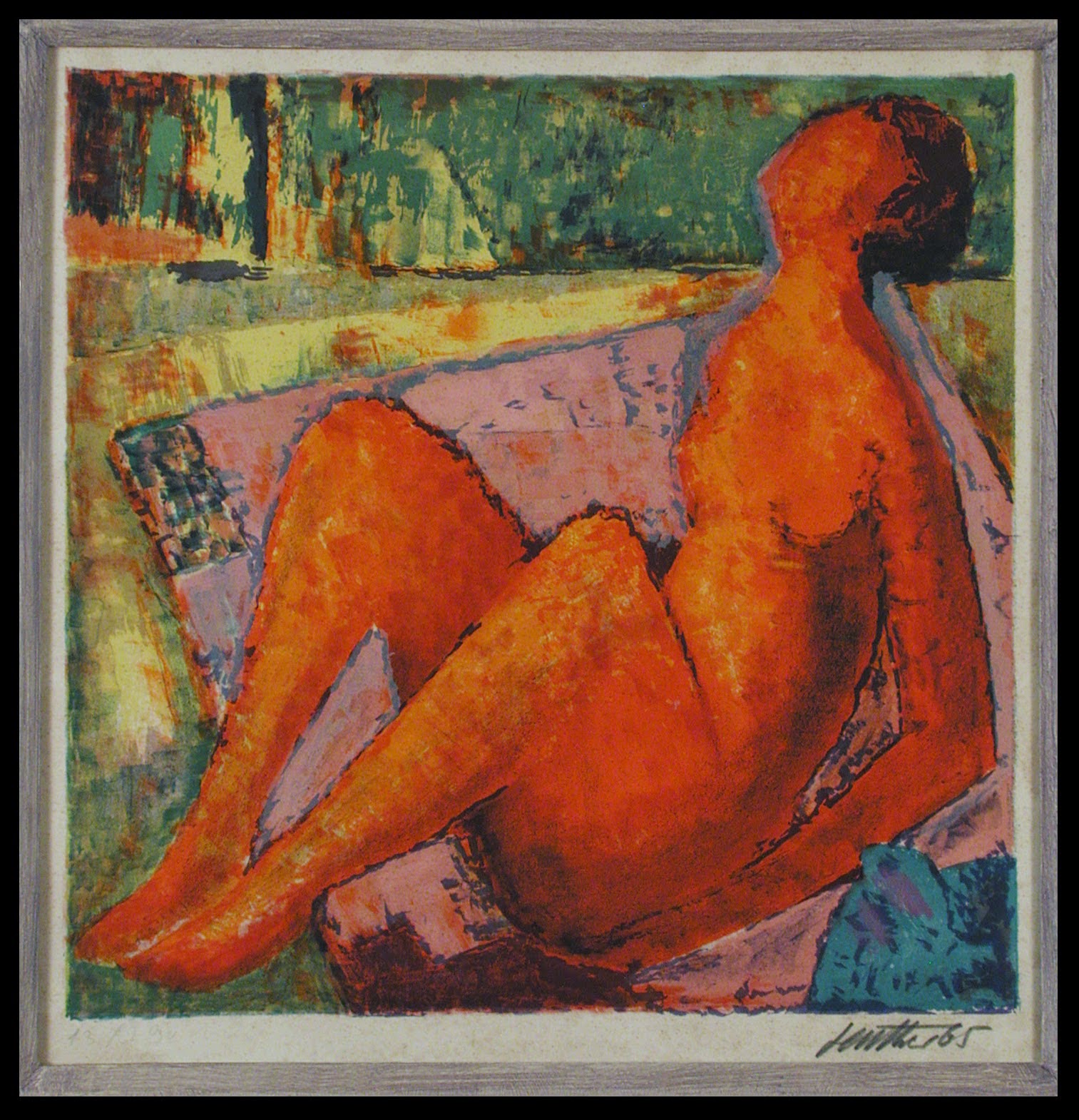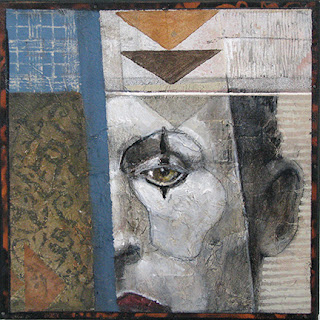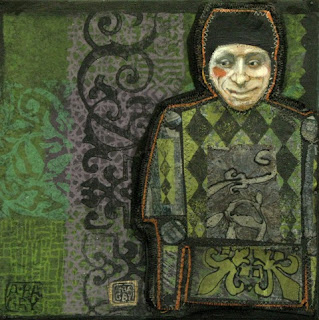I am always amazed when people ask me why the galleries are closed so long between the previous show and the opening of
Open Show. I think: REALLY?? Then I realize if you are not involved, you may not know how difficult and time consuming
Open Show is to produce - how many stages it goes through, and all the effort that is expended by the small army of volunteers we muster every year to pull the exhibition together.
Open Show has several phases: entry, jurying, critique writing/typing, entry pick-up, setting, hanging, finish work (lights and title cards), literature (brochure writing), and award cards & checks. On top of those we have two receptions to create around it - the Funder's Preview and the Opening Reception. Each phase carries very specific goals and tasks.
Entry: For entry we physically take the work. Each piece must be signed in, forms checked to be sure all the information is there (you would be surprised how many artists fail to fully fill out their forms), entry fees taken, and receipts written. Then the real work begins. We hang every piece for the juror - 349 this year - so the work can all be seen from both close up and some distance. This way the juror does not have to manipulate the work or handle it in any way. The crew, staunch volunteers all, become contortionists as they climb ladders, heft heavy work up high, and stretch themselves to the limits trying to make everything fit. This also requires a great "eye." We are careful to place items in the best position possible for every artist to get the best "look" from the juror. If you have a subtle piece, placing it next to a big, bold or busy piece, will certainly kill the chances of it being accepted into the show. We are very careful to try to give each piece, its' best chance. While this is going on, the information for every piece is being input into a database. Karen Evans has accepted this as her mission for the past several years. This gives us a working list to use for the juror when he comes to view the work.
Jurying: When we contract the juror, we always contract for the critique. If we didn't, we wouldn't get anyone who would talk about every piece. Can you imagine coming into the gallery filled with beautiful (and sometimes not so beautiful) work and saying something about all of them? All 349 of them? The juror typically looks at all the work before we begin, weighing what they see, considering the whole as well as each piece. On jurying day, we have a small bevy of scribes, individuals who come in to write down every word the juror says about each piece. The hope is that between all of us we get their full critique so it can be written down for the artist. This process is slow, but fascinating as the juror speaks, you get a glimpse of what he/she is seeing and how they are interpreting what they see. It is a mini course in Art History, composition, and sometimes specific techniques depending on the juror and the pieces they are viewing.
Critique Writing: The week or so after the juror determines the show is spent in constant work to pull the critiques together and get them in written form. This means taking the disjointed snatches of his comments and pulling them together in an understandable written form. So the scribble "left - strong col comp with grt use of cool pal, good line, sky ex. unusual perspective for trad land makes appealing"; becomes a look at the pieces to see which one is hanging on the left, then typing in the database " Strong color composition with great use of a cool color palette. Good use of line in the composition adds interest. Excellent sky. The unusual perspective utilized makes this traditional landscape appealing." Sometimes it becomes very involved as the juror discusses an aspect of composition or gives a short lesson based on the work at hand or uses a short cut reference and says - you know what to tell them. Yeah, but writing it takes a lot of time! Often the short cut refers to a piece we have just juried, so when writing the critiques I have to explain an idea or compositional element to which the juror just referred. In short, these take a long time. Often we work all day everyday on these pieces, then begin again after dinner and work well into the night just to get them down before the pieces go out. It makes a LOOOONNNNG week. This phase also includes printing out of the critique pages. This is a feat in itself. Databases do not like long fields, so sometimes this becomes a nightmare all its own.
Entry Pick-Up: As it takes days for the pieces to come in, so it takes for them to go out. Surprisingly, many artists do not understand that we do not have room to store their pieces beyond the time frame in the gallery. For us to begin setting the show, everything that is going home must be out of the gallery. It is difficult enough to consider all the pieces remaining in the exhibition, having to "look over" left over items is just not possible. In addition, we do not have secure storage or areas where they will be safe while so much activity is happening around them. If you care enough about it to enter it in a juried show, please care enough to pick it up on time. We try to have the critiques ready when you come so you can get both the work and the critique.
Setting: Setting a show is an art. We have terrific artists who come design the show every year. Every piece needs to find a place where it can be seen without being overwhelmed by the pieces next to it or overwhelming the pieces next to it. We work hard, for every piece to be placed in a happy situation. Sometimes this is easy, most often not. When 102 artists are involved like this year, it is difficult to find the perfect spot for all 110 pieces, but oh, how we try. We heft, tote, look, move again and look some more, break it apart and put it back together again, trying to find the sweet balance that makes a show pull together. We put a wall together, then have to tear it apart later when other pieces do not want to fit in the spaces left, and start over. We work, until every piece has a good place. We work until we all agree it is the best it can possibly be. This work takes days, sometimes even into a second week, before we find good placement for all the work. It is hard physical work - standing on hard concrete floors, lifting heavy pieces, lots of bending over and carrying. Beyond that, it is hard mental work - one must visualize, then move to see if that vision is realized. Often it is fatiguing just from the constant visual barrage.
Hanging: In this phase, we pound nails, lift all the work into place and then see if we are satisfied. Getting the right height is complicated by the varied eye lines in the individual pieces. Some pieces go best with works whose eye lines are inches, even feet, apart. Again, we try to come to a happy balance often requiring we move the piece up and/or down numerous times.
Finish Work: Once hung, we have several jobs to do to finish every show. We must set lights. Lighting can make or break a show. For the work to be seen well, it must be well lit.
Open Show is typically a very large show requiring we wash the walls with as much light as we can muster. There simply isn't enough room to leave breaks or to give emphasis with highlights and phrasing. That said, we have to move all of the lights into the best placement possible and, often, be creative. This year we purchased some extra LED lights that clipped onto the panels in the Foyer Gallery to add light to the end pieces which we simply could not light adequately from the central track. We had tried to find similar lights before to no avail, but Sue Thomas suggested we try again as she had seen some recently. Viola', a new look. After we light, we have to clean every piece. They get fingerprints, smudges, etc. when coming in and being handled in the gallery. This is a slow process, but since good lighting highlights those icky prints, very necessary. Title cards fall into this category also. We have to make the mail merge work just right to get all the information we wish onto the cards (easier than it sounds), check it for accuracy (the database does not have spell check and lots of these are being typed after midnight) and once printed, we have to hang them with pins. All these jobs are vital, but slow.
Literature: For every show we write a brochure giving specific information about the show, the artists, and the awards. This can be fast or slow. Then pieces have to be copied or taken to the printer. Since we keep the awards a secret until the opening, these are kept under wraps until that time. In addition, the title panels must be created and hung.
Award Cards and Checks: Open Show would not be
Open Show without the awards. We are fortunate to have several individuals who sponsor specific awards for this show. Each award needs to have the panel for it printed so it can be placed immediately after the awards presentation. In addition, the checks must be written, the envelopes created with award information, and then all pulled together and readied for the opening.
It would not be possible to present this show, especially with the features that make it the Art Center's Open Show, without the incredible work of our volunteers. The Art Center has essentially 2 full-time positions on staff. There is no way we could even begin to do this show without a tremendous volunteer effort. In 2011 we had a fabulous group of people who pulled the show. To these special people we all owe tremendous thanks for a job well done. We appreciate all your contributions of time, creativity, and energy. Volunteers were: Rickey Beene, Constance Capshaw, Karen Evans, Robert Evans, Len Fuller, Jean Gregory, Arlene Goldstine, Beatrice Guarneschelle– Holt, Barb McHugh, Betsy Spooner, Phil Stumbo, Janie Hiserote, and Sue Brasel Thomas. Some of these individuals were here all day for days, even into weeks! While volunteers, they were or are the staff that pulled the exhibition together. Other volunteers at the opening and for publicity were Constance Capshaw, Stephanie Holmes, Beatrice Guarneschelle-Holt, Louise McKown, Betsy Spooner, Pat Fitchpatrick, Stephanie Holmes, Donna Powers, Phil Stumbo, Janie Hiserote, Connie Valedon, Robert Evans, Kathleen Alexander, Jane Longendofer, and Bill Capshaw. We say thank you to all of them and hope you will also pass along your appreciation if you know or see them.
As you can see, creating Open Show is a large undertaking requiring varied and involved individuals with a diverse set of skills - Karen is great on the computer, Sue is great on the ladder, Jean has an incredible eye, etc.... It takes every single individual and every moment we can muster to pull it together in the time frame we have set aside. I hope you appreciate the amount of creative energy contributed for this project and enjoy the resulting exhibition. It is a labor of love - love for the art and for the Art Center.


















